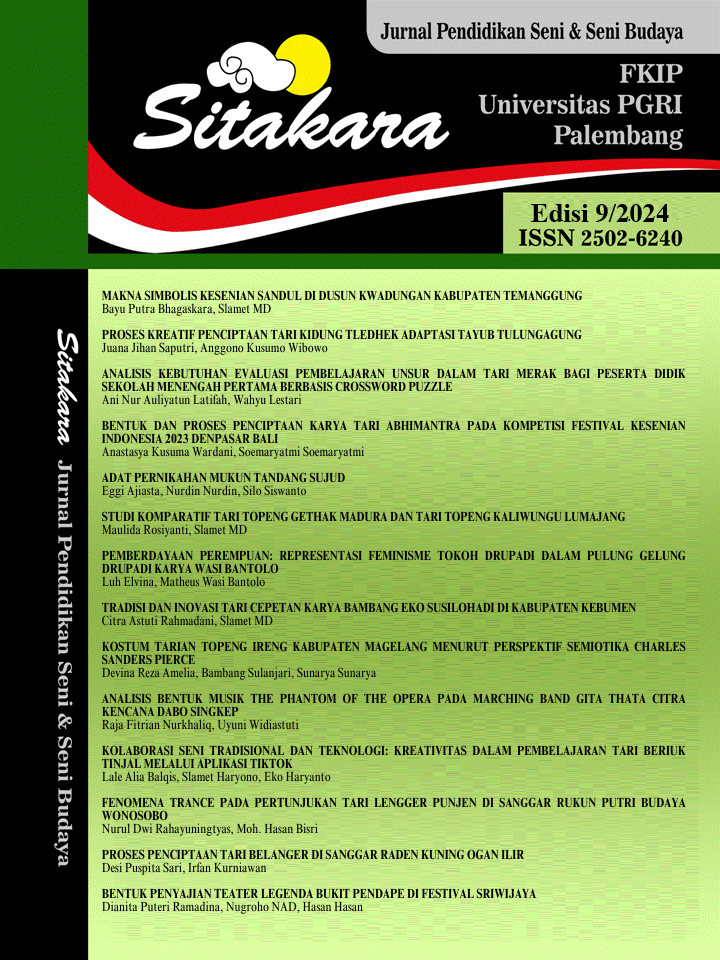PROSES KREATIF PENCIPTAAN TARI KIDUNG TLEDHEK ADAPTASI TAYUB TULUNGAGUNG
DOI:
https://doi.org/10.31851/sitakara.v9i2.14785Abstract
Abstrak
Penelitian ini bertujuan untuk mengetahui proses kreatif penciptaan karya tari Kidung Tledhek. Masalah difokuskan pada (1) Bagaimana bentuk koreografi tari Kidung Tledhek? (2) Bagaimana proses penciptaan tari Kidung Tledhek?. Guna mendekati masalah ini dipergunakan acuan teori dari Sumandiyo Hadi dalam bukunya yang berjudul Aspek-aspek koreografi kelompok, terdapat 10 elemen yang terdiri dari gerak, ruang, iringan musik, judul, tema, jenis tari, jumlah penari, tata rias dan busana, tata cahaya/ lighting, dan properti. Untuk membahas proses kreatif penciptaan menurut Prof. Dr. Sri Rochana tahapan penciptaan seni meliputi tehnik, eksplorasi, dan penyajian. Metode penelitian ini menggunakan jenis penelitian kualitatif dengan pendekatan koreografi yang ditekankan pada pengumpulan data, studi pustaka, wawancara, dan pengamatan oleh penulis. Hasil penelitian menunjukan bentuk koreografi berasal dari unsur tradisi namun dalam penggarapan karya tari ini menghasilkan suatu koreografi yang memberi nuansa baru.
Kata kunci: bentuk, kreativitas, koreografi.
Abstractions
This research aims to determine the creative process of creating the Kidung Tledhek dance work. The problem focuses on (1) What is the form of the Kidung Tledhek dance choreography? (2) What is the process of creating the Kidung Tledhek dance?. In order to approach this problem, refer to the theoretical reference from Sumandiyo Hadi in this book entitled Aspects of groups choreography, there are 10 elements consisting of movement, space, musical accompaniment, title, theme, type of dance, number of dancers, make-up and clothing, set lighting/lighting, and properties. To discuss the creative creation process according to Prof. Dr. Sri Rochana, the stages of creation include technical art, exploration and presentation. This research method uses a qualitative research type with a choreographic approach which emphasizes data collection, literature study, interviews and observation by the author. The reseach result show that the form of choreography comes from traditional elements, but in producing this dance work, a choreography that gives a new nuance is produced.
Keyword: form, creativity, choreography.
References
Hadi Sumandiyono, Y. (2012). Koreografi Bentuk Teknik Isi. Yogyakarta: Dwi-Quantum.
Moleong, Lexy J. (2007). Metodologi Penelitian Kualitatif. Bandung: Rosdakarya Bandung
Sri Rochana dan Wahyudiarto. (2014). Pengantar Koreografi. Surakarta: ISI Press Surakarta.
Soedarsono. (1978). Pengantar Pengetahuan dan Komposisi Tari. Yogyakarta: Akademi Seni
Tari Indonesia.
Hawkins, Alma M. (1990). Mencipta Lewat Tari, Terj. Y Sumandiyo Hadi. Yogyakarta: ISI
Yogyakarta.
Downloads
Published
How to Cite
Issue
Section
License
Copyright (c) 2024 Juana Jihan Saputri, Anggono Kusumo Wibowo

This work is licensed under a Creative Commons Attribution-ShareAlike 4.0 International License.
1. License
Use of articles will be governed by the Creative Commons Attribution - ShareAlike license as currently displayed on Creative Commons Attribution - ShareAlike 4.0 International License (CC BY-SA)
The author warrants that the article is original, written by stated author(s), has not been published before, contains no unlawful statements, does not infringe the rights of others, is subject to copyright that is vested exclusively in the author and free of any third party rights, and that any necessary written permissions to quote from other sources have been obtained by the author(s).
Jurnal Sitakara's spirit is to disseminate articles published are as free as possible. Under the Creative Commons license, Halaman Olahraga Nusantara permits users to copy, distribute, display, and perform the work. Users will also need to attribute authors and Jurnal Sitakara on distributing works in the journal and other media of publications.
4. Rights of Authors
Authors retain all their rights to the published works, such as (but not limited to) the following rights;
1. Copyright and other proprietary rights relating to the article, such as patent rights,
2. The right to use the substance of the article in own future works, including lectures and books,
3. The right to reproduce the article for own purposes,
4. The right to enter into separate, additional contractual arrangements for the non-exclusive distribution of the article's published version (e.g., post it to an institutional repository or publish it in a book), with an acknowledgment of its initial publication in this journal Sitakara.
5. Co-Authorship
If the article was jointly prepared by more than one author, any authors submitting the manuscript warrants that he/she has been authorized by all co-authors to be agreed on this copyright and license notice (agreement) on their behalf, and agrees to inform his/her co-authors of the terms of this policy. Jurnal Sitakara will not be held liable for anything that may arise due to the author(s) internal dispute. Jurnal Sitakara will only communicate with the corresponding author.
6. Royalties
Being an open accessed journal and disseminating articles for free under the Creative Commons license term mentioned, author(s) aware that Jurnal Sitakara entitles the author(s) to no royalties or other fees.
Sitakara Jurnal oleh http://univpgri-palembang.ac.id/e_jurnal/index.php/sitakara dilisensikan di bawah Lisensi Internasional Creative Commons Attribution-ShareAlike 4.0 .




.png)





















